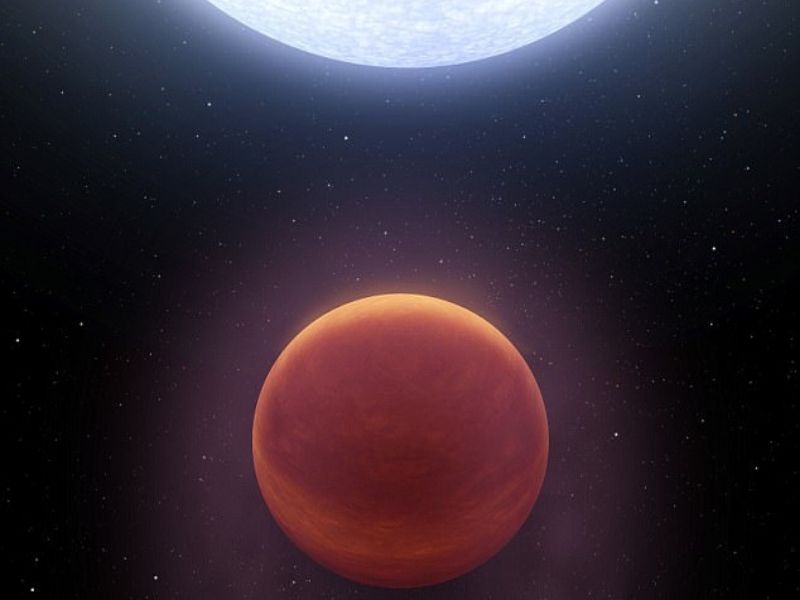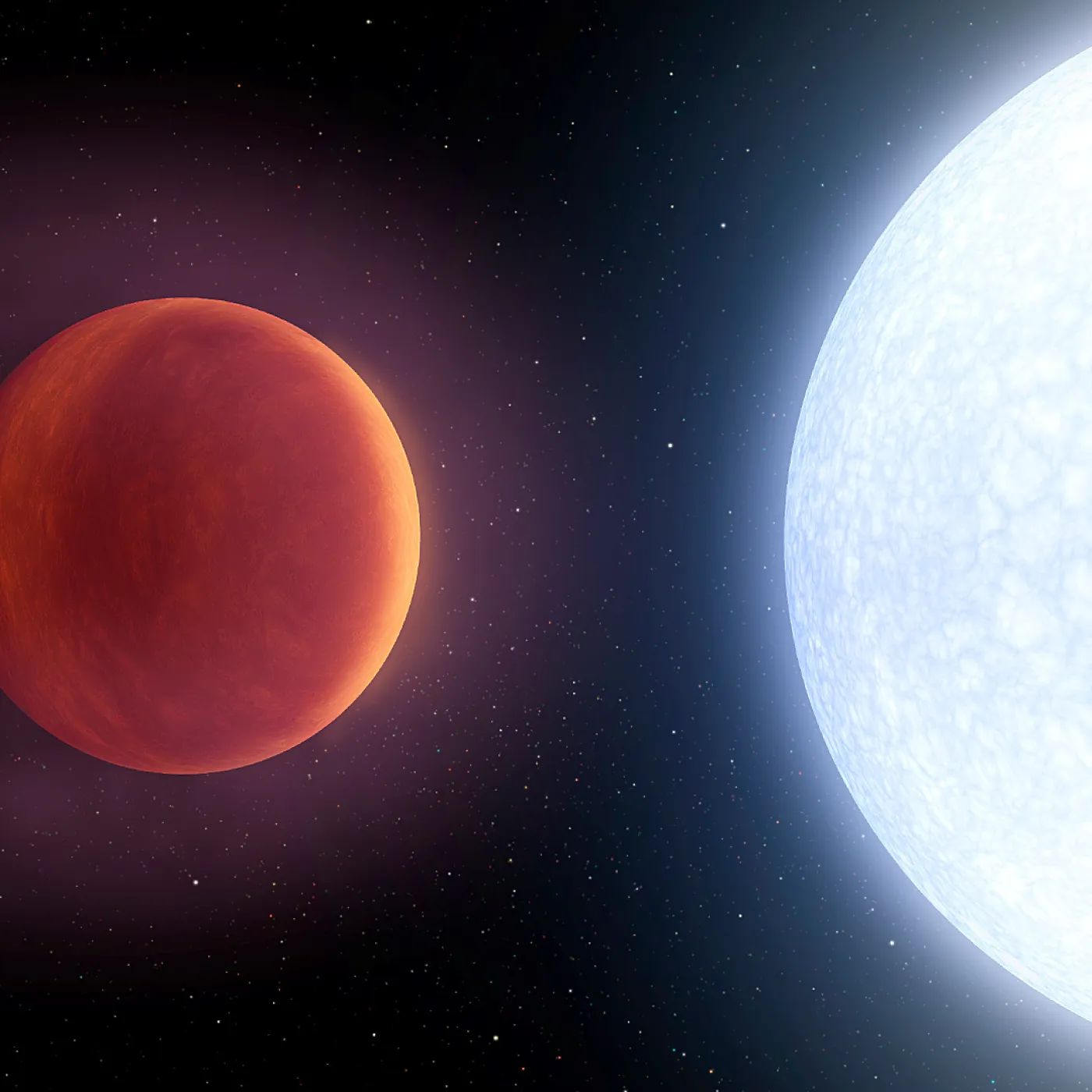KELT-9b: The Exoplanet With the Highest Temperature Ever Recorded

KELT-9b scorches the imagination as the hottest exoplanet ever discovered, a gas giant where temperatures soar beyond most stars.
Anúncios
Orbiting a blazing A-type star 670 light-years away in the constellation Cygnus, this ultra-hot Jupiter defies our understanding of planetary environments.
Its dayside reaches a staggering 7,800°F (4,300°C), hot enough to tear molecules apart and create a dynamic, almost apocalyptic atmosphere.
In this exploration, we’ll dive into the science, strangeness, and significance of KELT-9b, uncovering what makes it a cosmic marvel and a key to unlocking the mysteries of distant worlds.
Why does such an extreme planet captivate astronomers and challenge our assumptions about the universe?
A Star-Planet Hybrid in a Polar Dance
Imagine a world so close to its star that a single orbit—its “year”—lasts just 1.5 Earth days.
KELT-9b orbits its host star, KELT-9, at a mere 0.03462 AU, a distance so tight it’s tidally locked, with one side perpetually facing the star’s intense radiation.
Unlike typical planets orbiting a star’s equator, KELT-9b follows a polar orbit, swooping over the star’s poles in a path that baffled astronomers when first observed.
This unusual trajectory, combined with the star’s rapid rotation, creates a gravitational tug that warps the planet’s orbit over time, a phenomenon known as orbital precession.
The star itself is no ordinary sun.
KELT-9, classified as a late B-type or early A-type star, burns at 17,846°F (9,897°C), nearly twice as hot and massive as our Sun.
Its intense ultraviolet radiation bathes KELT-9b in energy 44,000 times greater than Earth receives, inflating the planet’s atmosphere like a cosmic balloon.
This gas giant, 2.8 times Jupiter’s mass but only half as dense, puffs up under the relentless stellar assault, losing material in a comet-like tail.
Picture a planet unraveling, its atmosphere evaporating into space, destined to either dwindle to a rocky core or be consumed when KELT-9 expands into a red giant in a billion years.
Table 1: KELT-9b vs. Jupiter Comparison
| Feature | KELT-9b | Jupiter |
|---|---|---|
| Mass | 2.8x Jupiter | 1x Jupiter |
| Density | Half of Jupiter’s | Standard for gas giants |
| Orbital Period | 1.48 days | 11.86 years |
| Dayside Temperature | 7,800°F (4,300°C) | -234°F (-145°C) |
| Distance from Star | 0.03462 AU | 5.2 AU |
+ New Astronomical Record: The Most Distant Planet Ever Detected by Humans
Molecular Meltdown: An Atmosphere in Chaos
The extreme heat on KELT-9b’s dayside doesn’t just warm the planet—it obliterates molecular bonds.
Hydrogen molecules, the building blocks of gas giants, dissociate into individual atoms under the star’s ferocious radiation.
These atoms drift to the cooler nightside, where temperatures drop just enough for them to recombine, only to be torn apart again when they cycle back to the dayside.
This constant cycle of destruction and reformation creates a dynamic atmosphere unlike any other known planet.
A 2020 study using NASA’s Spitzer Space Telescope confirmed this process, revealing how KELT-9b’s heat drives a unique atmospheric chemistry where heavy metals like iron and titanium vaporize into clouds, potentially condensing into metallic rain on the nightside.
Consider a hypothetical spacecraft approaching KELT-9b’s dayside.
Its sensors would detect a glowing, turbulent atmosphere, with temperatures rivaling the surfaces of K-type stars (around 4,600 K).
The craft’s hull would face a barrage of ultraviolet radiation, far beyond what any Earth-based material could withstand.
This isn’t a place for life or even robotic exploration—it’s a cosmic crucible, reshaping our understanding of planetary atmospheres.
The planet’s thermosphere, heated to 10,000–11,000 K by stellar radiation, pushes the boundaries of physics.
Ionized metals dominate, creating an environment where traditional molecular gases like water or methane can’t form.
This makes KELT-9b a natural laboratory for studying extreme conditions, offering clues about the atmospheres of other ultra-hot Jupiters and even the distant future of Earth when our Sun expands.

Two Summers, Two Winters: A Seasonal Paradox
KELT-9b’s polar orbit and the star’s rapid rotation create a bizarre seasonal cycle.
Unlike Earth’s gradual seasons, this exoplanet experiences two “summers” and two “winters” every 36 hours.
As it passes over KELT-9’s scorching poles, the planet endures peak temperatures, akin to standing under a cosmic blowtorch.
When it swings over the star’s cooler midsection, it enters a relative “winter,” though still blisteringly hot.
Observations from NASA’s Transiting Exoplanet Survey Satellite (TESS) in 2019 showed this cycle produces an asymmetric transit, with the planet blocking more light near the star’s bright poles than its dimmer equator.
This seasonal dance is like a feverish waltz, with KELT-9b caught in a rhythm dictated by its star’s gravity and heat.
The varying energy input creates an atmosphere in constant flux, with winds possibly reaching 60 kilometers per second if hydrogen dissociation isn’t accounted for, according to researcher Megan Mansfield.
These dynamics challenge astronomers to rethink how radiation and atmospheric flow balance in extreme environments, offering a glimpse into the diversity of exoplanetary systems.
Table 2: KELT-9b’s Seasonal Cycle
| Phase | Duration | Temperature Range | Key Feature |
|---|---|---|---|
| Summer (Pole) | ~9 hours | ~7,800°F (4,300°C) | Peak stellar radiation, molecule dissociation |
| Winter (Equator) | ~9 hours | Slightly cooler (~6,500°F) | Hydrogen recombination, atmospheric flow |
| Summer (Pole) | ~9 hours | ~7,800°F (4,300°C) | Repeated intense heating |
| Winter (Equator) | ~9 hours | Slightly cooler (~6,500°F) | Continued atmospheric cycling |
A Window into Earth’s Distant Future
KELT-9b’s hellish environment holds a mirror to the fate awaiting Earth billions of years from now.
In about 7.5 billion years, our Sun will expand into a red giant, potentially tidally locking Earth and subjecting one side to temperatures hot enough to melt basalt (around 4,000°F).
Like KELT-9b, Earth could develop a molten magma ocean on its dayside, with metallic vapors forming clouds that rain iron on the nightside.
This parallel, explored in a 2018 Forbes article, underscores the exoplanet’s value as a model for studying planetary evolution under extreme stellar influence.
Statistically, KELT-9b is an outlier: fewer than 0.1% of known exoplanets orbit stars as hot as KELT-9, making it a rare case study.
Its discovery in 2017 by the Kilodegree Extremely Little Telescope (KELT) team marked a milestone, as no B-type stars were previously known to host planets.
This rarity fuels questions about how such systems form.
Did KELT-9b migrate inward from a cooler orbit, or did it form in place, defying the intense radiation?
These puzzles drive research, with telescopes like Hubble and the James Webb Space Telescope poised to probe the planet’s evaporating atmosphere further.
For more information on the discovery of KELT-9b and its significance, visit NASA’s Exoplanet Exploration.

The Cosmic Laboratory of Ultra-Hot Jupiters
Beyond its record-breaking heat, KELT-9b represents a new class of exoplanets: ultra-hot Jupiters.
These gas giants, orbiting perilously close to their stars, push the limits of atmospheric and orbital dynamics.
For example, imagine a researcher modeling KELT-9b’s atmosphere on a supercomputer.
The simulation would reveal a chaotic interplay of ionized metals, supersonic winds, and evaporating gases, offering insights into how planets withstand—or succumb to—stellar extremes.
Such models could inform the study of other ultra-hot Jupiters, like WASP-33b, which, while cooler at 12,914°F (7,157°C), shares similar traits.
The planet’s polar orbit adds another layer of intrigue.
Unlike equatorial orbits, which produce predictable light dips during transits, KELT-9b’s path creates a “lopsided” transit, as noted in a 2020 study.
This anomaly helps astronomers refine techniques for detecting misaligned orbits, shedding light on the formation and migration of massive planets around high-mass stars.
Could KELT-9b’s orbit hint at a violent past, perhaps a gravitational tussle with another planet?
This question lingers, pushing scientists to explore the chaotic histories of exoplanetary systems.
++ What Would It Be Like to Live on Jupiter in the Future? Imagine a City in the Clouds
Why KELT-9b Matters
What makes KELT-9b more than a cosmic curiosity?
Its extreme conditions offer a testing ground for theories of planetary survival, atmospheric chemistry, and stellar interactions.
By studying this exoplanet, astronomers gain insights into the boundaries of planetary systems, from their formation to their eventual destruction.
Its evaporating atmosphere, metallic clouds, and polar orbit challenge conventional models, forcing us to rethink what’s possible in the universe.
For the public, KELT-9b sparks wonder and humility.
It’s a reminder that our pale blue dot is but one of countless worlds, some so alien they defy imagination.
As we peer 670 light-years away, we’re not just observing a planet—we’re glimpsing the universe’s capacity for extremes, creativity, and mystery.
KELT-9b invites us to ask: what other wonders await discovery, hidden in the fiery embrace of distant stars?
The exploration of such extreme environments not only expands our understanding of planetary science but also inspires future generations to look toward the stars.
As we continue to uncover the secrets of the universe, KELT-9b stands as a beacon of curiosity and exploration, challenging us to push the boundaries of human knowledge.
